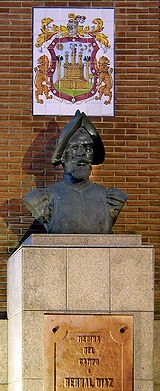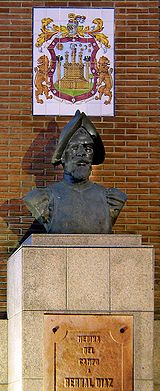
Bernal Díaz del Castillo
Encyclopedia
Bernal Díaz del Castillo (1492 – 1585) was a conquistador
, who wrote an eyewitness account of the conquest of Mexico
by the Spaniards for Hernán Cortés
, himself serving as a rodelero under Cortés.
 Bernal Díaz del Castillo was born 1492 in Medina del Campo
Bernal Díaz del Castillo was born 1492 in Medina del Campo
(Spain
), he came from a poor family and received little education. He sailed to Tierra Firme with the expedition led by Pedrarias Davila in 1514 to make his fortune, but after two years found few opportunities there. Many of the settlers had been sickened or killed by an epidemic, and there was political unrest.
, where he was promised a grant of Indian slaves (as a part of the Encomienda system). That promise was never fulfilled, leading Díaz, in 1517, to join an expedition being organized by a group of about 110 fellow settlers, and similarly disaffected Spaniards, from Tierra Firme. They chose Francisco Hernández de Córdoba
, a wealthy Cuban landowner, to lead the expedition. It was a difficult venture and although they discovered the Yucatán
coast, they later returned to Cuba in ruins.
Nevertheless, Díaz returned to the coast of Yucatán the following year, in an expedition led by Juan de Grijalva
, with the intent of exploring the newly discovered lands. Upon returning to Cuba, he enlisted in a new expedition, this one led by Hernán Cortés
.
. During this campaign, Díaz spoke frequently with his fellow soldiers about their experiences, collecting them into a narrative. The book that resulted from this was Historia verdadera de la conquista de la Nueva España (The True History of the Conquest of New Spain). In it he describes many of the 119 battles in which he participated, culminating in the defeat of the Aztecs in 1521. In the book, Castillo describes the Conquest of the Aztecs, in which he describes the Indoamerican cultures predominant in Mexico at that time. He also gives accounts of the human sacrifices, cannibalism and idolatry that he witnessed first hand.
, present-day Antigua Guatemala
. He finished writing his history in 1568, almost fifty years after the events described, a work he had begun (probably in the mid-1550s) in response to an alternative history written by Cortés's chaplain, who had not actually participated in the campaign. He called his book the Historia Verdadera ("True History"), in response to the claims made in the earlier work.
Díaz died in 1585, without seeing his book published. A manuscript was found in a Madrid
library in 1632 and published, providing an eye-witness account of the events, told from the perspective of a common soldier.
Among the greatness of the Aztec culture, Bernal describes a pretty well organized market place and beautifully arranged botanical and zoological gardens.
Conquistador
Conquistadors were Spanish soldiers, explorers, and adventurers who brought much of the Americas under the control of Spain in the 15th to 16th centuries, following Europe's discovery of the New World by Christopher Columbus in 1492...
, who wrote an eyewitness account of the conquest of Mexico
Spanish conquest of Mexico
The Spanish conquest of the Aztec Empire was one of the most important campaigns in the Spanish colonization of the Americas. The invasion began in February 1519 and was acclaimed victorious on August 13, 1521, by a coalition army of Spanish conquistadors and Tlaxcalan warriors led by Hernán Cortés...
by the Spaniards for Hernán Cortés
Hernán Cortés
Hernán Cortés de Monroy y Pizarro, 1st Marquis of the Valley of Oaxaca was a Spanish Conquistador who led an expedition that caused the fall of the Aztec Empire and brought large portions of mainland Mexico under the rule of the King of Castile in the early 16th century...
, himself serving as a rodelero under Cortés.
Early life

Medina del Campo
Medina del Campo is a town located in the middle of the Spanish Meseta Central, in the province of Valladolid, Castile-Leon autonomous region, 45 km from Valladolid. It is the capital of a farming area, far away from the great economic centres.-History:...
(Spain
Spain
Spain , officially the Kingdom of Spain languages]] under the European Charter for Regional or Minority Languages. In each of these, Spain's official name is as follows:;;;;;;), is a country and member state of the European Union located in southwestern Europe on the Iberian Peninsula...
), he came from a poor family and received little education. He sailed to Tierra Firme with the expedition led by Pedrarias Davila in 1514 to make his fortune, but after two years found few opportunities there. Many of the settlers had been sickened or killed by an epidemic, and there was political unrest.
Expedition to Yucatán
He later sailed to CubaCuba
The Republic of Cuba is an island nation in the Caribbean. The nation of Cuba consists of the main island of Cuba, the Isla de la Juventud, and several archipelagos. Havana is the largest city in Cuba and the country's capital. Santiago de Cuba is the second largest city...
, where he was promised a grant of Indian slaves (as a part of the Encomienda system). That promise was never fulfilled, leading Díaz, in 1517, to join an expedition being organized by a group of about 110 fellow settlers, and similarly disaffected Spaniards, from Tierra Firme. They chose Francisco Hernández de Córdoba
Francisco Hernández de Córdoba (discoverer of Yucatán)
Francisco Hernández de Córdoba was a Spanish conquistador, known to history mainly for the ill-fated expedition he led in 1517, in the course of which the first European accounts of the Yucatán Peninsula were compiled.-1517 Expedition:...
, a wealthy Cuban landowner, to lead the expedition. It was a difficult venture and although they discovered the Yucatán
Yucatán Peninsula
The Yucatán Peninsula, in southeastern Mexico, separates the Caribbean Sea from the Gulf of Mexico, with the northern coastline on the Yucatán Channel...
coast, they later returned to Cuba in ruins.
Nevertheless, Díaz returned to the coast of Yucatán the following year, in an expedition led by Juan de Grijalva
Juan de Grijalva
Juan de Grijalva was a Spanish conquistador. Some authors said he was from the same family as Diego Velázquez.He went to Hispaniola in 1508 and to Cuba in 1511....
, with the intent of exploring the newly discovered lands. Upon returning to Cuba, he enlisted in a new expedition, this one led by Hernán Cortés
Hernán Cortés
Hernán Cortés de Monroy y Pizarro, 1st Marquis of the Valley of Oaxaca was a Spanish Conquistador who led an expedition that caused the fall of the Aztec Empire and brought large portions of mainland Mexico under the rule of the King of Castile in the early 16th century...
.
Conquest of Mexico
In this third effort, Díaz took part in the campaigns against the AztecAztec
The Aztec people were certain ethnic groups of central Mexico, particularly those groups who spoke the Nahuatl language and who dominated large parts of Mesoamerica in the 14th, 15th and 16th centuries, a period referred to as the late post-classic period in Mesoamerican chronology.Aztec is the...
. During this campaign, Díaz spoke frequently with his fellow soldiers about their experiences, collecting them into a narrative. The book that resulted from this was Historia verdadera de la conquista de la Nueva España (The True History of the Conquest of New Spain). In it he describes many of the 119 battles in which he participated, culminating in the defeat of the Aztecs in 1521. In the book, Castillo describes the Conquest of the Aztecs, in which he describes the Indoamerican cultures predominant in Mexico at that time. He also gives accounts of the human sacrifices, cannibalism and idolatry that he witnessed first hand.
Governor of Antigua Guatemala and later life and death
As a reward for his service, Díaz was appointed governor of Santiago de los CaballerosSantiago de los Caballeros
Santiago de los Caballeros is a city in the Dominican Republic. Founded in 1495 during the first wave of European colonization of the New World, today Santiago is the second largest metropolis in the Dominican Republic, located in the north-central region of the Republic known as Cibao valley...
, present-day Antigua Guatemala
Antigua Guatemala
Antigua Guatemala is a city in the central highlands of Guatemala famous for its well-preserved Spanish Mudéjar-influenced Baroque architecture as well as a number of spectacular ruins of colonial churches...
. He finished writing his history in 1568, almost fifty years after the events described, a work he had begun (probably in the mid-1550s) in response to an alternative history written by Cortés's chaplain, who had not actually participated in the campaign. He called his book the Historia Verdadera ("True History"), in response to the claims made in the earlier work.
Díaz died in 1585, without seeing his book published. A manuscript was found in a Madrid
Madrid
Madrid is the capital and largest city of Spain. The population of the city is roughly 3.3 million and the entire population of the Madrid metropolitan area is calculated to be 6.271 million. It is the third largest city in the European Union, after London and Berlin, and its metropolitan...
library in 1632 and published, providing an eye-witness account of the events, told from the perspective of a common soldier.
Among the greatness of the Aztec culture, Bernal describes a pretty well organized market place and beautifully arranged botanical and zoological gardens.

